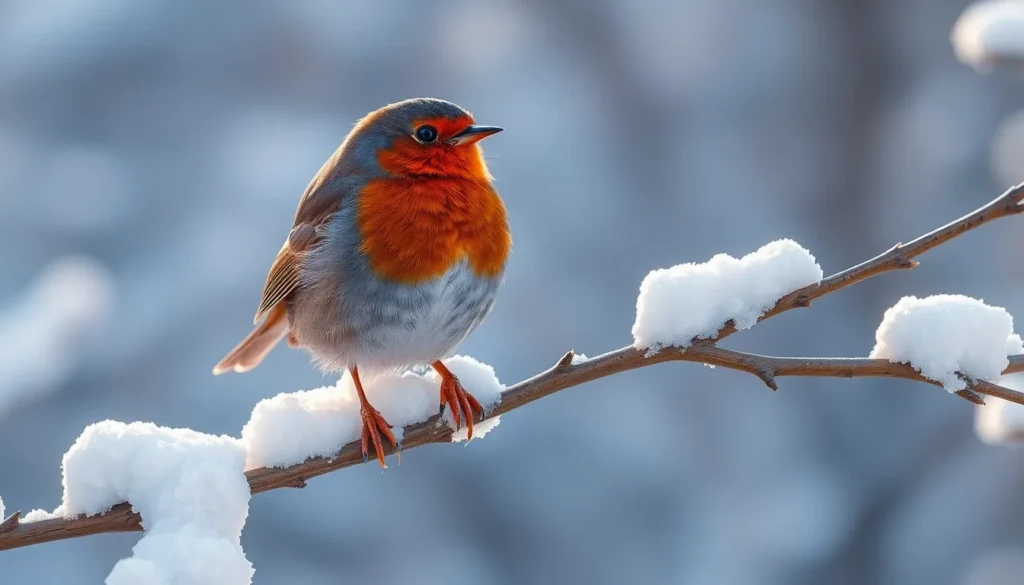When we spot that familiar flash of orange-red breast hopping across our lawn, we’re witnessing one of nature’s most powerful messengers. The American robin isn’t just a harbinger of spring – it’s a bird steeped in rich symbolism that spans cultures, traditions, and spiritual beliefs across North America.
For centuries, we’ve looked to these cheerful songbirds as symbols of renewal, hope, and new beginnings. Their unwavering presence in our backyards and neighborhoods has woven them into the fabric of American folklore, making them one of the most spiritually important birds in our collective consciousness.
Whether you’ve been seeing robins repeatedly or you’re simply curious about their deeper meaning, understanding robin symbolism can offer profound insights into life’s cycles and personal transformation. We’ll explore the intriguing area of American robin meanings and discover why these beloved birds continue to capture our hearts and imaginations.
The American Robin: A Symbol of Renewal and Hope
The American robin embodies renewal across North American cultures through its distinctive role as spring’s herald. These vibrant birds emerge from winter’s harsh grip to announce nature’s awakening with their melodic songs echoing through neighborhoods and woodlands. Cultural traditions throughout the continent recognize robins as messengers carrying promises of fresh starts and brighter days ahead.
Spring’s arrival becomes undeniably real when robins appear in our backyards after months of winter dormancy. Their bright red breasts create striking contrasts against snow-covered landscapes, signaling that warm weather approaches within weeks. Native American tribes historically viewed robin sightings as confirmation that planting season had begun, making these birds essential to agricultural timing.
Hope manifests through robin symbolism in multiple spiritual traditions across the United States and Canada. Many communities interpret robin encounters as divine messages encouraging perseverance during challenging times. The bird’s ability to thrive in harsh conditions while maintaining its cheerful disposition inspires countless individuals facing personal struggles.
Renewal symbolism extends beyond seasonal changes to cover personal transformation and spiritual growth. Robins represent our capacity to emerge from difficult periods with renewed strength and purpose. Their annual migration patterns mirror human experiences of leaving familiar territories to discover new opportunities for growth and fulfillment.
The American robin’s resilience demonstrates how creatures adapt to changing environments while maintaining their essential nature. These birds successfully navigate urban expansion, climate variations, and habitat modifications without losing their fundamental characteristics. Their adaptability serves as a powerful metaphor for human flexibility and the ability to find hope in unexpected circumstances.
Spiritual practitioners often view robin appearances as confirmation that positive changes approach their lives. The timing of these encounters frequently coincides with important life transitions, career shifts, or relationship developments. Many people report feeling encouraged to pursue new directions after meaningful robin sightings during pivotal moments.
Cultural Significance Across Different Traditions
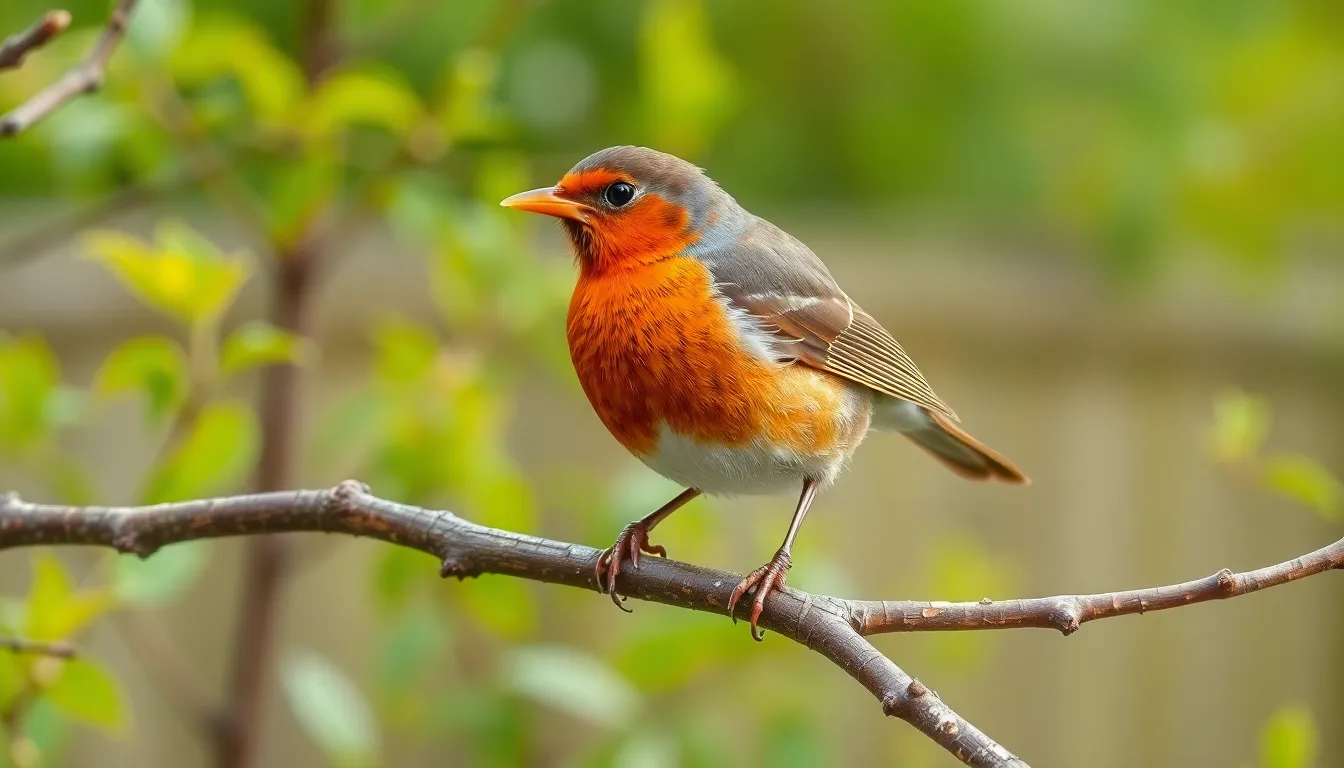
The American robin’s symbolism transcends geographical boundaries and cultural lines, weaving itself into the spiritual fabric of diverse communities throughout North America. Different traditions have embraced unique interpretations of this beloved bird, creating a rich tapestry of meaning that continues to evolve today.
Native American Beliefs and Folklore
Indigenous tribes across North America recognize the robin as a powerful spiritual messenger connecting the physical and spiritual realms. Many Native American communities view these birds as spirit guides that emphasize the importance of family bonds, courtship rituals, and maintaining a strong home foundation.
The Blackfoot tribe specifically associates robins with peace and safety, believing their presence ensures protection for camps and villages from potential attacks. Tribal elders often point to robin sightings as indicators that an area remains free from danger and conflict.
Fire mythology plays a central role in several Native American robin legends. Some tribal stories portray the robin as a guardian of sacred fire, while others depict the bird as a clever thief who stole fire for humanity’s benefit. These tales explain the robin’s distinctive red breast as a mark left by flames.
The Hopi tribe designates the robin as a directional guardian associated with the south, incorporating the bird into their complex spiritual geography. This connection links robins to warmth, growth, and the life-giving properties of southern winds.
Historically, Native American agricultural communities relied on robin sightings to determine optimal planting times, recognizing these birds as reliable indicators of seasonal changes and favorable growing conditions.
European Immigrant Influences
European settlers brought established robin folklore from their homelands, adapting these beliefs to match their encounters with American robins. Traditional European interpretations connected the robin redbreast to good fortune, passionate love, and spiritual rebirth.
These immigrant communities merged their ancestral beliefs with observations of American robins, creating hybrid symbolism that reinforced themes of renewal and positive transformation. European folklore often depicted robins as harbingers of divine messages and miraculous occurrences.
The adaptation process involved reconciling visual differences between European and American robin species while preserving core symbolic meanings. Settlers maintained their cultural connections to robin symbolism even though encountering a different species entirely.
Religious influences from European Christianity also shaped robin interpretations, with some communities linking the bird’s red breast to Christ’s blood and themes of sacrifice and redemption.
Modern American Symbolism
Contemporary American culture embraces the robin as a quintessential symbol of spring’s arrival and hope’s renewal. Literature, art, and media consistently portray robins as positive omens representing fresh opportunities and beneficial life changes.
The robin’s close association with residential areas strengthens its symbolic connection to home, family, and domestic harmony. Modern interpretations emphasize the bird’s industrious nature and devoted parenting behaviors as models for human relationships.
Urban and suburban communities particularly value robin symbolism because these birds thrive in human-modified environments. Their adaptability resonates with modern Americans handling rapidly changing social and technological landscapes.
Social media and digital platforms have amplified robin symbolism, with countless posts and images celebrating robin sightings as moments of joy and spiritual significance. This digital presence ensures the bird’s symbolic relevance continues growing among younger generations.
Environmental awareness movements have also adopted robin symbolism to represent nature’s resilience and the importance of preserving habitats that support both wildlife and human communities.
Spiritual and Religious Meanings
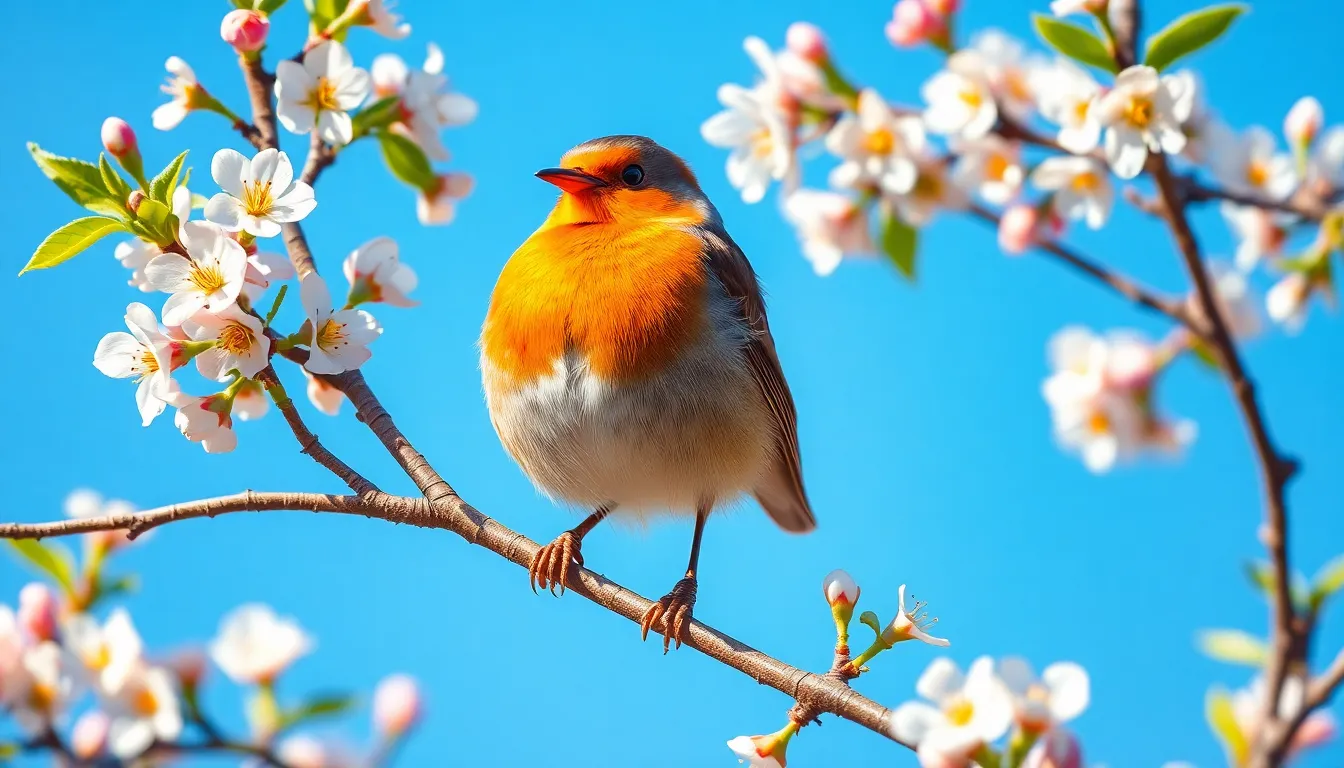
Robins carry profound spiritual significance across many religious traditions and belief systems. These remarkable birds serve as messengers of divine guidance and symbols of spiritual transformation in our lives.
Christian Symbolism
Christian traditions view the American robin as a sacred messenger from Heaven, sent by angels to provide comfort during our most challenging moments. The bird’s appearance often signals divine reassurance, encouraging us to maintain faith and trust in God’s plan for our future. Robins embody the spirit of compassion and selfless service, reflecting the teachings found in Saint Francis’s prayer about alleviating suffering through simple acts of kindness.
Churches and Christian communities frequently interpret robin sightings as angelic visitations, particularly when these birds appear during times of grief or uncertainty. The robin’s bright red breast symbolizes the blood of Christ and represents sacrifice, love, and redemption in Christian iconography. Many believers find solace in robin encounters, viewing them as confirmation that departed loved ones rest peacefully in God’s embrace.
General Spiritual Interpretations
Spiritual practitioners across various traditions recognize robins as powerful spirit animals that bring clarity, joy, protection, and healing from grief into our lives. These birds appear as spiritual escorts, guiding souls through transitions from this life to the next while offering comfort to those left behind. Robins encourage us to embrace change with courage and cultivate inner spiritual growth through their persistent presence and melodic songs.
Many cultures designate robins as relationship birds, emphasizing their connection to family bonds, community building, and the nurturing of loving hearts. The robin’s tendency to live near human habitats reinforces its role as a familiar spiritual guide throughout life’s major transitions. Spiritual teachers often point to robin sightings as opportunities for personal evolution, helping us recognize and respond to moments of spiritual awakening and deeper connection with the divine.
| Spiritual Aspect | Meaning | Tradition |
|---|---|---|
| Divine Messenger | Sign of hope and renewal | Christian |
| Angelic Visitation | Comfort during grief | Christian |
| Spirit Guide | Clarity and protection | General Spirituality |
| Relationship Symbol | Family and community bonds | Cross-Cultural |
| Transition Guide | Spiritual evolution support | Universal |
The Robin as a Messenger of Seasonal Change
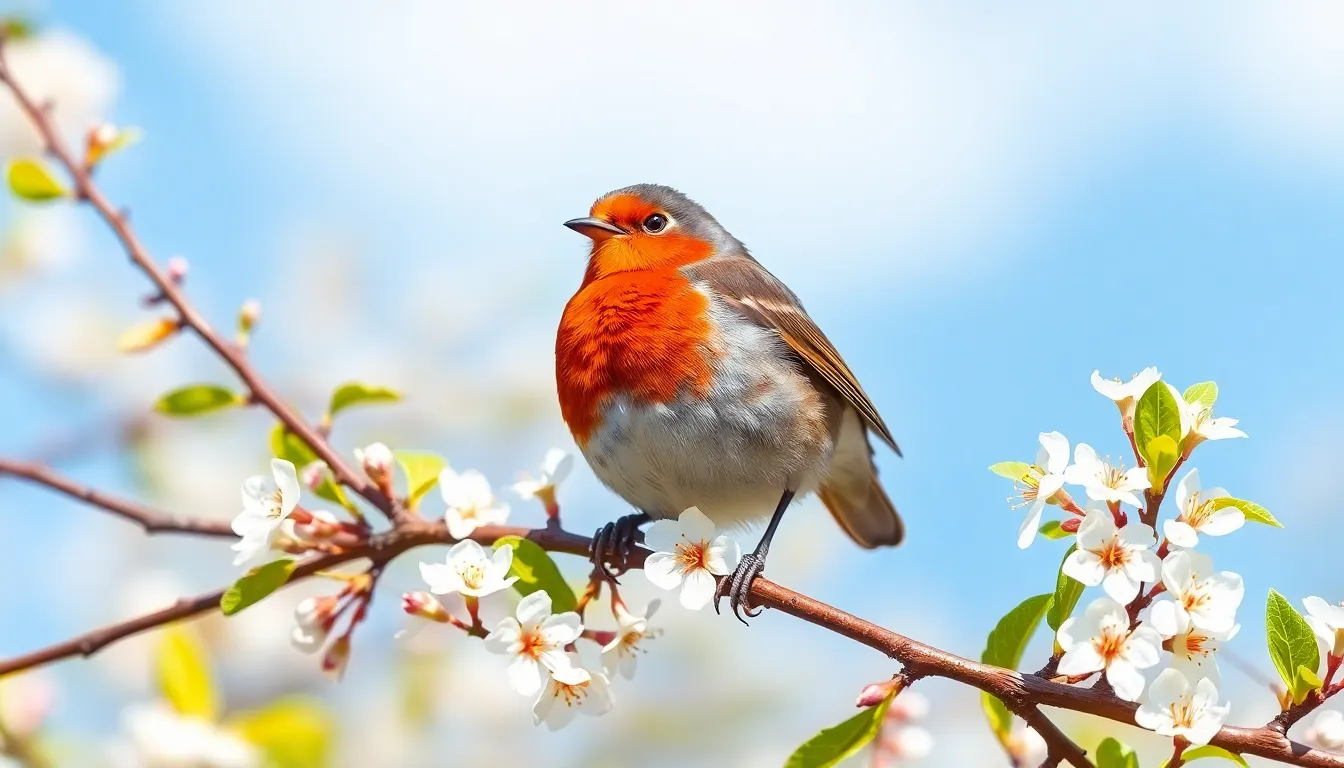
American robins serve as nature’s most reliable messengers of seasonal transformation. We witness their profound ability to signal the transition from winter’s dormancy to spring’s awakening across North America.
Spring Arrival and New Beginnings
American robins establish themselves as harbingers of spring through their migratory patterns and early seasonal appearances. Many cultures celebrate the robin’s return as a marker of spring’s renewal and the promise of better times ahead. Their arrival coincides with warmer weather patterns and marks the definitive end of winter across various regions.
Fresh starts become possible when we observe robins returning to familiar territories with their cheerful songs and vibrant plumage. Personal projects gain momentum during robin season, as these birds signal opportunities for emotional renewal and major life changes. Communities eagerly anticipate robin sightings because they represent hope and the approaching cycle of growth.
Spring renewal manifests through the robin’s consistent behavior patterns that align with seasonal transitions. Brighter days approach when robins begin their active foraging and nesting activities. Their presence transforms landscapes from winter’s bleakness into environments filled with possibility and new beginnings.
Connection to Growth and Rebirth
Growth symbolism flows naturally from the American robin’s association with life-giving energy and solar connections. Native American traditions link robins directly to the sun and its vital force across multiple tribal cultures. Some tribes interpret the robin’s red breast as a reflection of the sun’s rays, symbolizing warmth and vitality in their spiritual practices.
Rebirth themes emerge through the robin’s industrious nature and nurturing behaviors toward their young. Communities experience peace and security when robins establish nesting sites nearby. Their parental dedication demonstrates the cyclical nature of life and the importance of caring for future generations.
Spiritual transformation occurs when we recognize robins as intermediaries between physical and metaphysical worlds. Important themes of family, home, courtship, and authentic expression flow through their symbolic presence. The robin’s universal representation of transformation reinforces our understanding of life’s continuous cycles of renewal and growth.
Dream Interpretation and Personal Symbolism

Dreams featuring American robins carry powerful messages about transformation and spiritual awakening. These nocturnal visions often reflect our subconscious connection to renewal and positive change.
Common Robin Dream Meanings
Dreams featuring robins symbolize fresh starts and overcoming challenges, with interpretation varying based on exact dream context. Seeing robins in dreams represents new opportunities approaching your life, particularly when they appear singing or building nests. Flying robins indicate freedom from past limitations and readiness to embrace personal growth.
Robin eggs in dreams symbolize potential waiting to unfold, suggesting creative projects or relationships developing in your waking life. Dead robins may represent the end of one life phase before another begins, not necessarily negative but transformational. Multiple robins gathering signifies community support during upcoming changes.
Feeding robins in dreams indicates your nurturing nature and desire to help others through difficult transitions. Injured robins suggest healing processes occurring within yourself or close relationships. Robin chicks hatching represent new ideas or projects ready to manifest in reality.
Personal Encounters and Their Significance
Robin sightings serve as signs of positive change and new opportunities entering your life. Behavioral encounters carry exact meanings according to various folklore traditions and spiritual interpretations. Robins tapping on windows often signify messages from the spiritual area, particularly communications from deceased loved ones.
Persistent robin visits to your yard indicate spiritual protection and guidance during important life decisions. Robins appearing during difficult times provide reassurance that better circumstances approach. Finding robin feathers suggests angels or spirit guides offering encouragement and support.
Robins building nests near your home symbolize stability and family blessings coming your way. Early morning robin songs represent divine messages about new beginnings and spiritual awakening. Robins following you during walks indicate your intuitive abilities strengthening and prophetic vision developing.
If robins consistently appear during meditation or prayer, they’re confirming your spiritual path and encouraging continued growth. Indoor robin encounters, though rare, signify urgent spiritual messages requiring immediate attention and action.
Literature and Popular Culture References
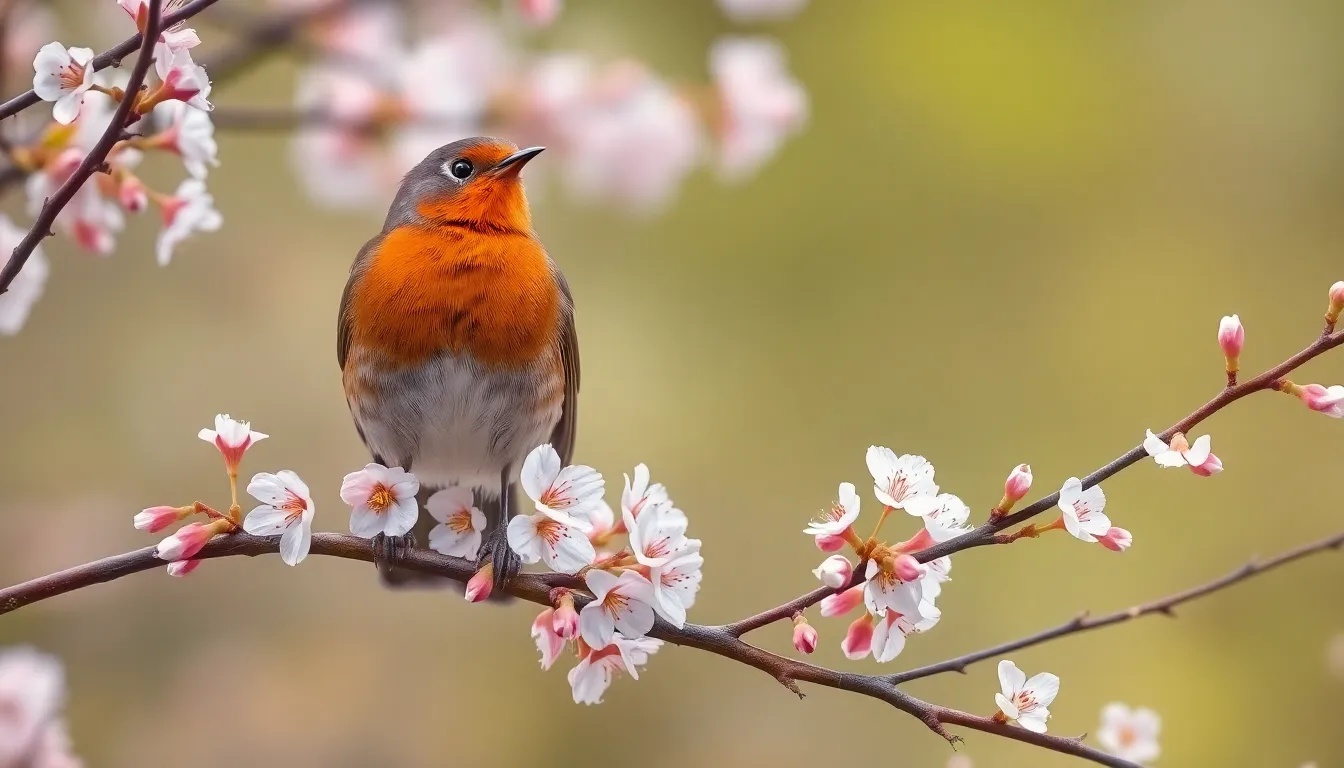
American robins have woven themselves into our cultural consciousness through countless literary works and popular expressions. We encounter these beloved birds across various forms of artistic expression that celebrate their symbolic significance.
Famous Poems and Songs
Poetry has long embraced the American robin as a symbol of hope and renewal. We find robins featured prominently in works by Emily Dickinson, who wrote about their cheerful songs announcing spring’s arrival. Traditional folk songs like “When the Red, Red Robin Comes Bob, Bob, Bobbin’ Along” celebrate the bird’s joyful nature and its connection to positive change.
Contemporary songwriters continue drawing inspiration from robin symbolism in their compositions. We see references to robins in songs about new beginnings, lost love, and seasonal transitions. Musicians often use the robin’s red breast and melodic voice as metaphors for passion and hope in their lyrics.
Classical literature frequently incorporates robins as harbingers of spring and messengers of renewal. We observe these birds appearing in works that explore themes of rebirth and transformation, particularly in poetry collections focused on nature and seasonal change.
Children’s Stories and Folklore
Children’s literature has embraced the American robin as a gentle character representing safety and family values. We discover robins featured in countless picture books where they serve as wise guides helping young protagonists navigate challenges. These stories often emphasize the robin’s role as a protective figure and symbol of home.
Native American folklore presents robins as spiritual messengers connecting the physical and spiritual worlds. We learn from these traditional stories how robins gained their distinctive red breasts and became symbols of sacrifice and love. Blackfoot tales specifically portray robins as peace symbols indicating safety from harm.
European folklore traditions merged with American interpretations created rich storytelling traditions around robins. We find tales explaining how robins became associated with Christmas and winter survival, often featuring themes of kindness rewarded and hope sustained during difficult times.
Modern children’s literature continues incorporating robin symbolism in stories about friendship, perseverance, and environmental stewardship. We see contemporary authors using robins to teach children about nature’s cycles, the importance of family bonds, and finding courage during challenging situations.
How to Interpret Robin Sightings in Your Life
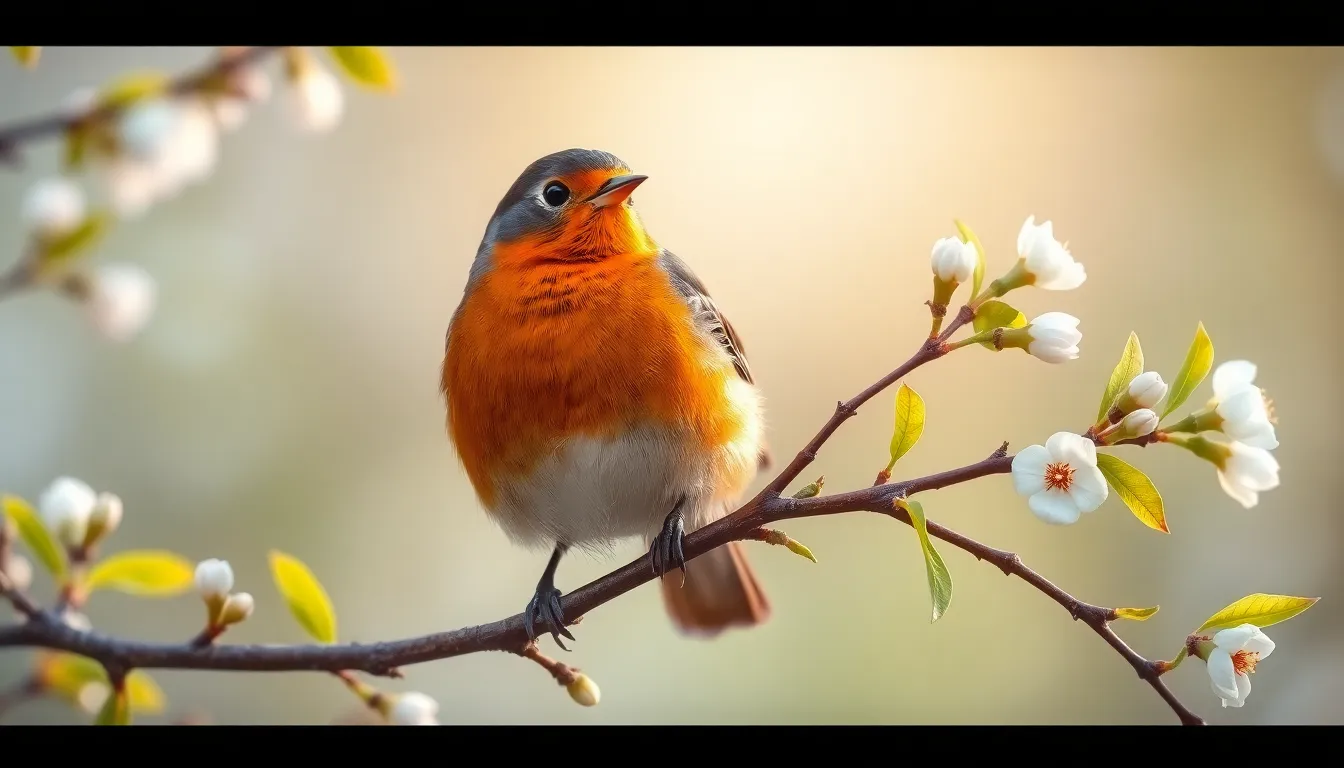
Interpreting robin sightings in your life starts with understanding the context and timing of these meaningful encounters. We observe that robins often appear during periods of important change, serving as harbingers of good news and positive developments in upcoming projects or life transitions.
Context-Based Interpretation Methods
Consider the exact circumstances surrounding your robin sighting to unlock its deeper meaning. A robin appearing during difficult times signals the approaching end of challenging periods and encourages maintaining a positive outlook. Robins spotted during major life decisions indicate that your future receives support from higher powers, reminding you that you’re not alone in your journey.
Seasonal and Timing Significance
Spring robin sightings carry the strongest symbolism of renewal and fresh starts, marking the perfect time for new beginnings. Early morning encounters with robins suggest clarity and prophetic vision, similar to how the Iroquois and Shoshone tribes interpreted the white ring around the robin’s eye. Winter robin sightings hold special meaning, representing hope during the darkest times and resilience in the face of adversity.
Behavioral Patterns and Their Meanings
Observe the robin’s behavior to gain deeper insights into the message being conveyed. Singing robins indicate upcoming joy and positive news, while robins building nests near your home symbolize family blessings and stability. Multiple robin sightings suggest persistent spiritual messages encouraging you to embrace community connections and strengthen family bonds.
Personal Reflection Prompts
Ask yourself exact questions when encountering robins to enhance your interpretation. Does this sighting coincide with thoughts about career changes or relationship developments? Are you currently facing decisions that require wisdom and clarity? Robin appearances often prompt reflection on living in the present moment and letting go of past limitations.
Spiritual Guidance Recognition
Recognize robin sightings as messages from the spiritual area, particularly when they occur repeatedly or in unusual circumstances. These encounters frequently signal that you possess intuitive and visionary abilities, encouraging you to trust your inner wisdom and offer guidance to others. The robin’s red breast reminds us to speak truthfully, while its yellow beak symbolizes the importance of using words carefully, as understood in Native American traditions.
Conclusion
The American robin stands as one of nature’s most powerful symbols connecting us to cycles of renewal and transformation. Whether we encounter these remarkable birds through dreams personal sightings or cultural traditions they consistently remind us of our capacity for growth and resilience.
Their presence in our lives often signals that we’re ready for positive changes and fresh beginnings. Focusing to robin encounters and reflecting on their timing we can gain valuable insights into our spiritual journey and life transitions.
As we continue to share our industry with these adaptable messengers we’re reminded that hope persists even in our darkest seasons. The American robin’s enduring symbolism across cultures speaks to universal human experiences of renewal hope and the eternal promise that spring will always follow winter.
Frequently Asked Questions
What does the American robin symbolize?
The American robin symbolizes renewal, hope, and new beginnings across various cultures. It represents the herald of spring, emerging from winter to signal nature’s awakening. In spiritual traditions, robins are seen as messengers of fresh starts and divine reassurance, with their bright red breast contrasting against winter landscapes to announce warmer weather ahead.
Why are robins considered spiritual messengers?
Robins are considered spiritual messengers because they appear during significant life transitions and challenging times, offering comfort and guidance. In Christian traditions, they’re viewed as sacred messengers from Heaven, while Native American tribes see them as powerful spirit guides emphasizing family bonds, peace, and protection throughout life’s major changes.
What does it mean when you see a robin in your dreams?
Dreams featuring American robins represent transformation, spiritual awakening, and subconscious connections to renewal. Common interpretations include fresh starts, overcoming challenges, and new opportunities. Singing or nest-building robins in dreams signify readiness for personal growth, while flying robins indicate freedom from past limitations and spiritual progression.
How do different cultures interpret robin sightings?
Native American tribes view robins as indicators for planting season and spiritual guides representing family safety. The Blackfoot associate them with peace and protection, while the Hopi connect them to warmth and growth. European settlers merged their folklore with American interpretations, reinforcing themes of renewal and spiritual rebirth in modern culture.
What should I do when I repeatedly see robins?
Repeated robin sightings suggest spiritual messages and potential intuitive abilities developing. Pay attention to the timing and context of these encounters, as they often coincide with significant life changes. Reflect on your current situation, consider upcoming decisions, and remain open to positive transformations and new opportunities in your life.
Do robins represent family and community connections?
Yes, robins strongly symbolize family bonds and community connections. Their nurturing behaviors toward their young, nest-building activities, and tendency to return to familiar territories represent stability, family blessings, and the importance of maintaining strong relationships. They serve as reminders to cherish family ties and community support systems.

